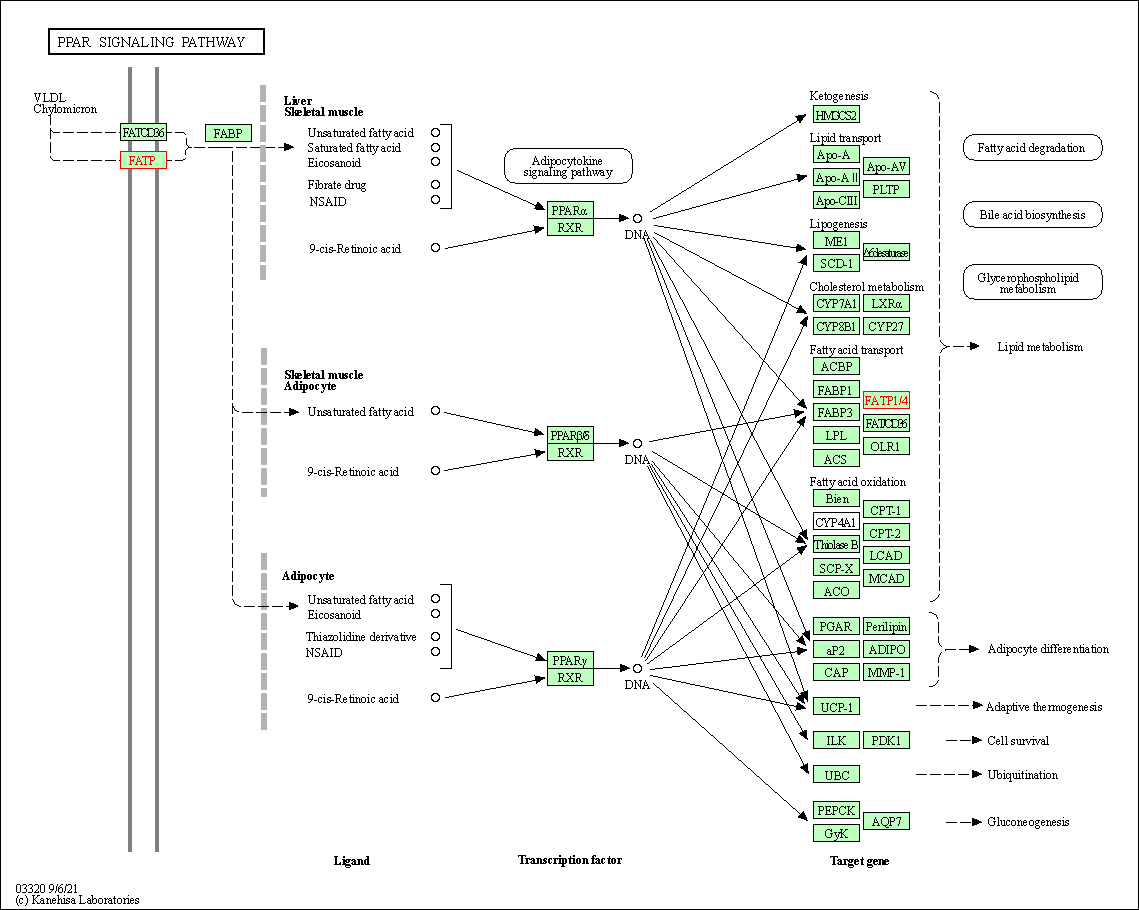Target Information
| Target General Information | Top | |||||
|---|---|---|---|---|---|---|
| Target ID |
T40545
(Former ID: TTDR00838)
|
|||||
| Target Name |
Solute carrier family 27 member 4 (SLC27A4)
|
|||||
| Synonyms |
Long-chain fatty acid transport protein 4; Fatty acid transport protein 4; FATP4; FATP-4; ACSVL4
Click to Show/Hide
|
|||||
| Gene Name |
SLC27A4
|
|||||
| Target Type |
Literature-reported target
|
[1] | ||||
| Function |
Involved in translocation of long-chain fatty acids (LFCA) across the plasma membrane. Appears to be the principal fatty acid transporter in small intestinal enterocytes. Plays a role in the formation of the epidermal barrier. Required for fat absorption in early embryogenesis. Has acyl-CoA ligase activity for long-chain and very-long-chain fatty acids (VLCFAs). Indirectly inhibits RPE65 via substrate competition and via production of VLCFA derivatives like lignoceroyl-CoA. Prevents light-induced degeneration of rods and cones (By similarity).
Click to Show/Hide
|
|||||
| BioChemical Class |
Carbon-sulfur ligase
|
|||||
| UniProt ID | ||||||
| EC Number |
EC 6.2.1.-
|
|||||
| Sequence |
MLLGASLVGVLLFSKLVLKLPWTQVGFSLLFLYLGSGGWRFIRVFIKTIRRDIFGGLVLL
KVKAKVRQCLQERRTVPILFASTVRRHPDKTALIFEGTDTHWTFRQLDEYSSSVANFLQA RGLASGDVAAIFMENRNEFVGLWLGMAKLGVEAALINTNLRRDALLHCLTTSRARALVFG SEMASAICEVHASLDPSLSLFCSGSWEPGAVPPSTEHLDPLLKDAPKHLPSCPDKGFTDK LFYIYTSGTTGLPKAAIVVHSRYYRMAALVYYGFRMRPNDIVYDCLPLYHSAGNIVGIGQ CLLHGMTVVIRKKFSASRFWDDCIKYNCTIVQYIGELCRYLLNQPPREAENQHQVRMALG NGLRQSIWTNFSSRFHIPQVAEFYGATECNCSLGNFDSQVGACGFNSRILSFVYPIRLVR VNEDTMELIRGPDGVCIPCQPGEPGQLVGRIIQKDPLRRFDGYLNQGANNKKIAKDVFKK GDQAYLTGDVLVMDELGYLYFRDRTGDTFRWKGENVSTTEVEGTLSRLLDMADVAVYGVE VPGTEGRAGMAAVASPTGNCDLERFAQVLEKELPLYARPIFLRLLPELHKTGTYKFQKTE LRKEGFDPAIVKDPLFYLDAQKGRYVPLDQEAYSRIQAGEEKL Click to Show/Hide
|
|||||
| Cell-based Target Expression Variations | Top | |||||
|---|---|---|---|---|---|---|
| Cell-based Target Expression Variations | ||||||
| Different Human System Profiles of Target | Top |
|---|---|
|
Human Similarity Proteins
of target is determined by comparing the sequence similarity of all human proteins with the target based on BLAST. The similarity proteins for a target are defined as the proteins with E-value < 0.005 and outside the protein families of the target.
A target that has fewer human similarity proteins outside its family is commonly regarded to possess a greater capacity to avoid undesired interactions and thus increase the possibility of finding successful drugs
(Brief Bioinform, 21: 649-662, 2020).
Human Tissue Distribution
of target is determined from a proteomics study that quantified more than 12,000 genes across 32 normal human tissues. Tissue Specificity (TS) score was used to define the enrichment of target across tissues.
The distribution of targets among different tissues or organs need to be taken into consideration when assessing the target druggability, as it is generally accepted that the wider the target distribution, the greater the concern over potential adverse effects
(Nat Rev Drug Discov, 20: 64-81, 2021).
Human Pathway Affiliation
of target is determined by the life-essential pathways provided on KEGG database. The target-affiliated pathways were defined based on the following two criteria (a) the pathways of the studied target should be life-essential for both healthy individuals and patients, and (b) the studied target should occupy an upstream position in the pathways and therefore had the ability to regulate biological function.
Targets involved in a fewer pathways have greater likelihood to be successfully developed, while those associated with more human pathways increase the chance of undesirable interferences with other human processes
(Pharmacol Rev, 58: 259-279, 2006).
Human Similarity Proteins
Human Tissue Distribution
Human Pathway Affiliation
|
|
|
There is no similarity protein (E value < 0.005) for this target
|
|
Note:
If a protein has TS (tissue specficity) scores at least in one tissue >= 2.5, this protein is called tissue-enriched (including tissue-enriched-but-not-specific and tissue-specific). In the plots, the vertical lines are at thresholds 2.5 and 4.
|
| KEGG Pathway | Pathway ID | Affiliated Target | Pathway Map |
|---|---|---|---|
| PPAR signaling pathway | hsa03320 | Affiliated Target |

|
| Class: Organismal Systems => Endocrine system | Pathway Hierarchy | ||
| Fat digestion and absorption | hsa04975 | Affiliated Target |

|
| Class: Organismal Systems => Digestive system | Pathway Hierarchy | ||
| References | Top | |||||
|---|---|---|---|---|---|---|
| REF 1 | Identification of the major intestinal fatty acid transport protein. Mol Cell. 1999 Sep;4(3):299-308. | |||||
If You Find Any Error in Data or Bug in Web Service, Please Kindly Report It to Dr. Zhou and Dr. Zhang.

